This recipe makes about 35 eclairs. For my audience, that means about two each, and everyone would have been more than glad to have more. Next time, maybe I will, because this recipe leaves you with 12 egg whites, which is only enough for one angel food cake. We really need two cakes to properly go around. Needless to say, this is a recipe I tend to make most often in when the spring chickens are putting out a dozen eggs a day. It’s all too easy to a get a gross of eggs sitting in the refrigerator if one doesn’t take drastic action such as this.
Pastry dough:
Line baking pans with parchment paper, and preheat oven to 425.
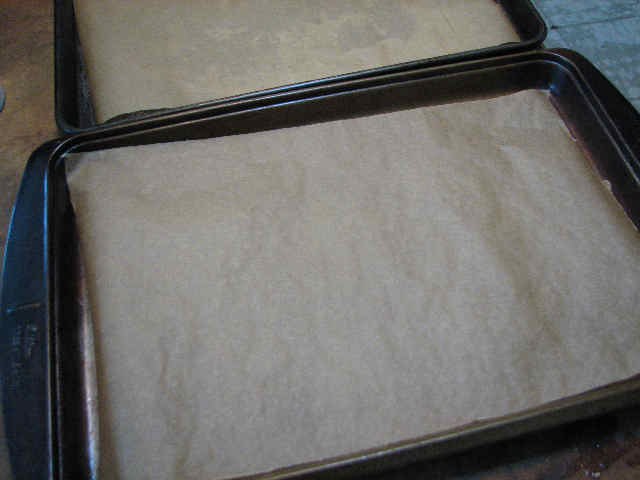
Ingredients:
2 cups water
2 sticks butter
1 tsp. salt
1 TB. sugar
2 cups flour
6 to 8 eggs
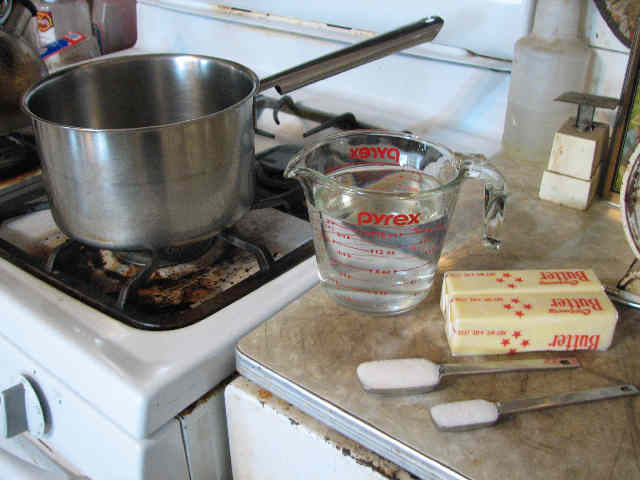
Bring the water, butter, salt and sugar to a rolling boil.

When it comes to a boil, turn off the heat, and dump in the flour all at once.
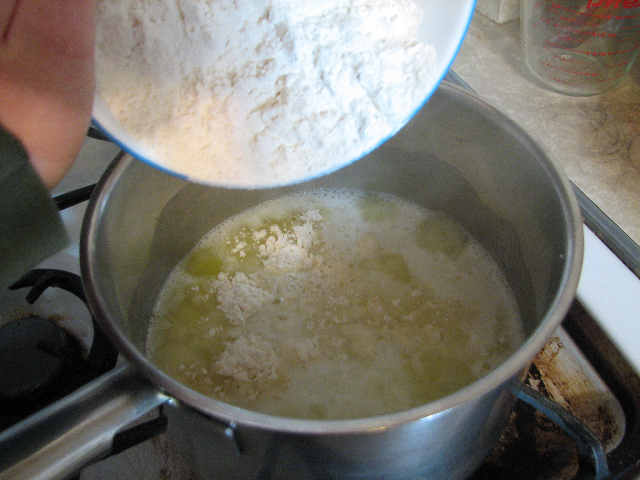

Stir hard for 30-60 seconds. At this point, it will sort of look like a stiff paper mache paste.

Return to heat, and cook, still stirring hard, for another 30 or so seconds. After this point, the original recipe recommends switching to a stand mixer with a paddle, or using a hand mixer. I continued to use my wooden stirring paddle, but it did give me a bit of a work out. It is very stiff, and kind of glossy. Start adding the eggs, one by one.
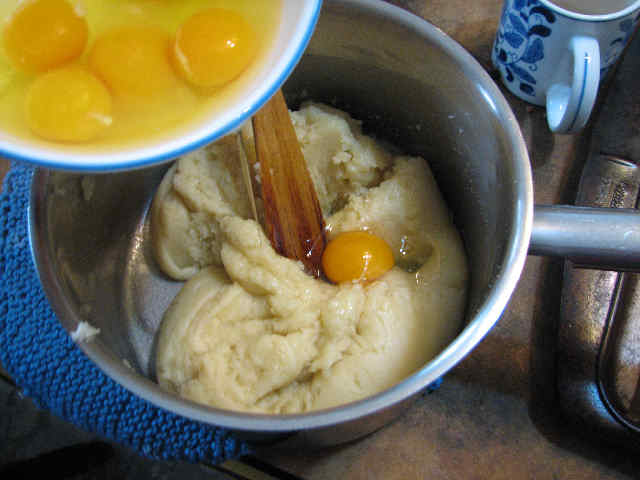
At first the mixture will separate and slip and slide; then it will join together and seem just as stiff as ever.

The original recipe said the mixture should be soft enough to slip off the paddle (I needed to use 7 or 8 eggs to get it that way), but I found I actually had an easier time forming the eclairs after the mixture had cooled to the point it was too stiff to slide off the paddle. You may want to stop at 6 eggs if you’re new to using a pastry bag.

Alas, I couldn’t take pictures and pipe the eclairs at the same time, and I didn’t have anyone taking pictures at the time. So some of these following photos are part of a mock-up. Here’s a quick crash course in pastry bags.
These are the components: pastry bag, the parts to the coupler, and a decorative tip. (The pastry bag shown is a small decorator bag. Sometimes I use that, and sometimes I use disposable pastry bags.)

When I pipe the eclairs, I use my coupler with out any tip in it. This makes it easier to get an eclair the size I want it. I keep the notch in the coupler facing towards the baking sheet, to keep the eclairs more uniform. If you do use a tip, you rest the metal tip over the coupler, and then fasten it on with the coupler ring.

Fold back a cuff before you load the bag; it keeps the mess down, and the bag is easier to handle if it’s not slippery.

Also, folding down that cuff keeps you from loading the bag too high. That means you still have enough bag left to twist the end shut. If you don’t firmly twist the end shut then when you squeeze the bag it will backfire—major mess and no filling coming out the little tip like it’s supposed to.
The twist is held shut with the thumb and pointer; the rest of the fingers control the pressure on the bag.

The other hand guides the tip.

As you use up the filling, you will need to squeeze the last bits down, {the mess is do mostly to impatience; more on that in the assembly instructions}
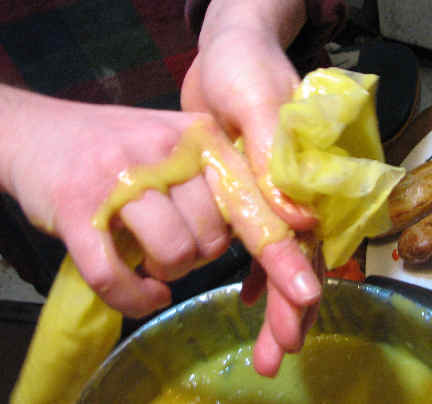
and re-twist the bag.

As for making the eclairs, you can really make them any shape or size you want. But they do puff up considerably in the oven. A general rule of thumb is that if you pipe out the filling the size of a hot-dog, you will wind up with an eclair the size of a hog-dog roll. You’ll need to move slowly and squeeze firmly.
Piped eclairs.
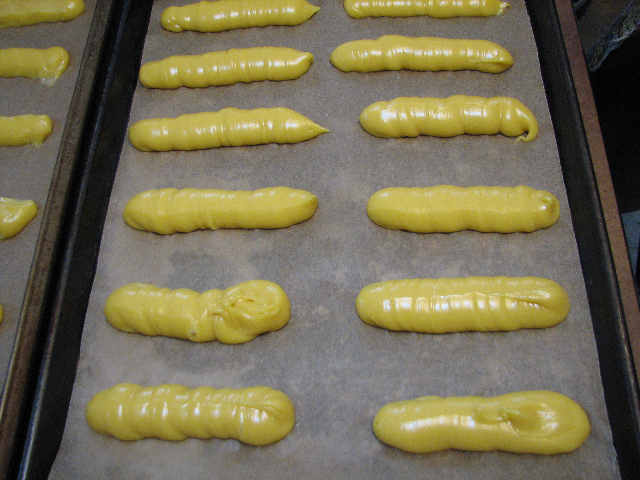
(I needed to use 3 pans, but it’s unwise to use more than 2 pans at a time in the oven. I piped the last pan after the first two came out, reusing the parchment. At that point, the dough was stiffer and easier to pipe. If you only used 6 eggs, you may find it too stiff to do it this way, and you may want to pipe all the eclairs at one time). At this point, you will probably have at least 6 people ask you why you are piping the filling before you bake the shells. Even if they asked you the same question last time you made them.
If your eclairs have funny lumps and bulges (mine? never!) they can be easily smoothed out with a wet finger. Don’t fret too much about it, though, because the puffing they do in the oven covers a multitude of sins.
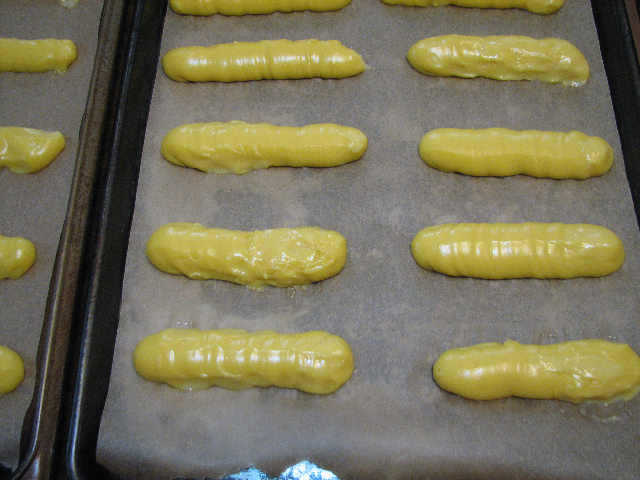
Next use a pastry brush to brush all the piped elcairs with an egg mixed with 1/2 TB water. This give the elcairs a nice gloss, but doesn’t do much else. So it’s okay to forget or deliberately omit this step.
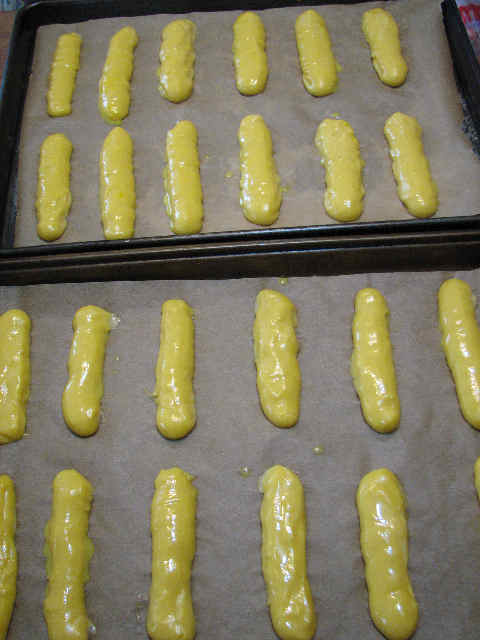
Bake in the pre-heated oven for 15 minutes, then reduce the heat to 375 for about another 25 minutes. When you reduce the heat, you should rotate the pans, top to bottom and left to right, but other than that, keep the oven closed. Steam is what makes the eclairs puff, and if you keep opening and closing the oven, you’ll wind up with flat eclairs.
They should be a light golden brown when they’re finished. If you under-cook them, they’ll look great when you first take them out, but as they cool, they’ll deflate. They’ll be a little squishy or mushy, too, but you can make them work. If you over bake them, the can get a little burnt on the bottom. (And if you don’t rotate the pans, you’ll get one burnt pan and one mushy pan.) I’ve done both, and my advice is to err on the side of over baking. All the cream and chocolate pretty well drowns out a little over-browning on the bottom, but squishy, flat, eclairs are less appetizing (but still quite edible). This is a pretty good representation of their color when their done.

These shells came out perfect. . .

. . . but since no cooking session is complete without a minor disaster, I messed up a bit on the filling. Learn from my mistakes, and make the filling the day before—filling the eclairs is much less than pleasant if your filling isn’t 100% chilled. If you made the shells early in the morning, and got right on the filling, you can still do it all in one day. If you do like what I did—namely, get distracted reading Howl’s Moving Castle until 11:30 am, and not even get started on the filling till mid-afternoon—well, you’ll be filling eclairs at 8 pm with filling that’s not properly set, and a horde of hungry barbarians standing over your shoulder.
Filling:
6 cups milk
2 vanilla beans or else vanilla extract.
1 1/2 cups sugar
1 cup + 2 TB flour
3/4 cup cornstarch
12 egg yolks
6 TB butter
This is an adapted filling recipe; the original didn’t call for any type of vanilla. Usually I just use real vanilla extract in my baking, but since The Cheese Trap had some in that week, I decided to try real beans for once. (It was a $4 for 2 beans, much less expensive than Wegman’s was carrying them for. The Cheese Trap is sort of a general store/co-op sort of place. I know they buy their stuff from co-ops, and then re-package to sell.) Since the recipe doesn’t originally call for vanilla of any type, I don’t know how much extract to recommend. I tried using only one vanilla bean, and found it had too mild of a flavor for me, so I wound up using two.
I cut the beans into thirds, and let them steep in 1 cup warm milk until the beans were soft. (Bring the milk and beans to a boil, then turn off heat and let sit 15 minutes.) Then I scraped out the seeds, and let the whole thing steep longer. It’s supposed to be enough to just steep them in warm milk, but if I used beans again, I would make the custard the day before, and leave the beans sitting in the custard till I needed it. They’re easy to pick out, and will keep giving off flavor as long as they’re sitting it.

[Note on vanilla flavors: I cannot stand fake vanilla extract–it tastes so very fake to me, like some “vanilla-scented” toy I used to have as a kid, not like anything actually meant for eating. What I found interesting is that the vanilla beans smell more like fake vanilla extract than real vanilla extract. As far as taste, the beans seem to straddle the difference between fake and real vanilla extract. Real extract tastes more “brown”, deeper and more of a dried taste (as a prune is more dried and concentrated than a plumb). However, the fake vanilla extract is too fake–too sweet, too sickly, and too overpowering. The real vanilla bean still carries some of the fruitiness the fake extract imitates, but is more mellow and full flavored than the fake extract. I still recommend real vanilla extract over fake vanilla extract, but if you want a real vanilla flavor, the beans are best. However, most people probably won’t even notice a difference unless you grill them.]
Put sugar, flour, and cornstarch in your pan, and whisk it together.

Whisk in your remaining 5 cups of milk until there are no lumps.
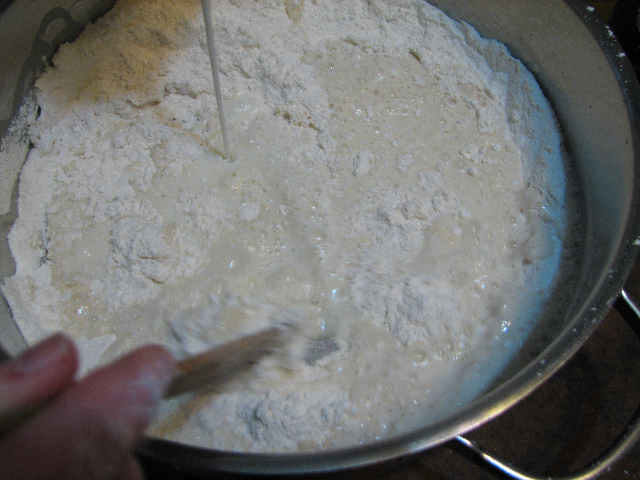
Cook over medium heat, stirring constantly, until thick and no longer has a raw, starchy taste (which can take up to 30 minutes).
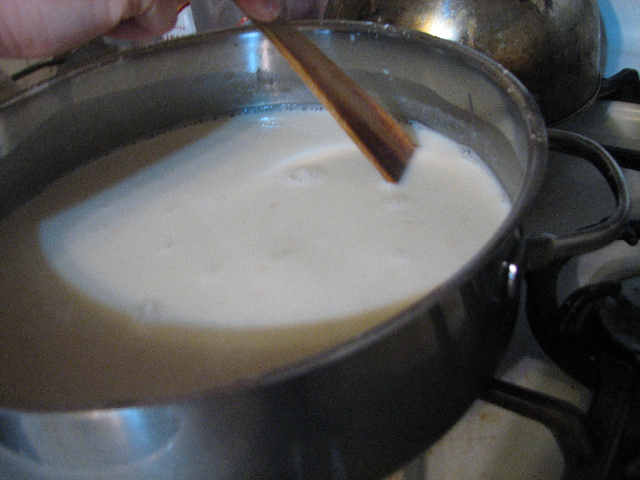
If you cook it on high heat, it will thicken up too quickly and on the bottom first. That will leave with clumps of thick filling on the bottom, and loose, soupy filling on the top. This can usually be remedied with lower heat and vigorous whisking, but it’s best to just avoid it in the first place and cook it on a lower heat. This was a time I had the heat on too high (I forgot my front burner was hotter than typical), so I found the filling thickened before the starchy taste was gone. I continued to cook it, over low-heat, till it didn’t taste so raw. I whisked in my remaining cup of milk/vanilla beans at this point, because I didn’t want to keep the vanilla beans that hot for so long; I’m thinking the flavor might not be that sturdy.
Next you need to add the egg yolks. This whole beautiful dozen of eggs needs to be separated,
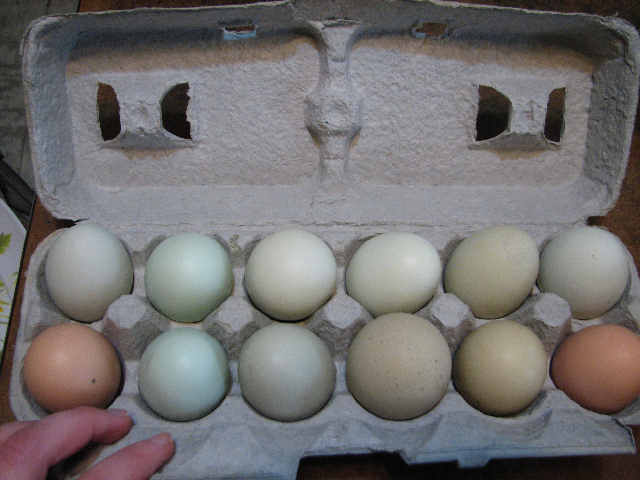
like this.

Some people use the shells, some people use fancy gadgets, but I’ve found hands work the best. First crack your egg into a small tea-cup, so if the yolk decides to split open on you, you can just set that contrary egg aside and try again. Then dump the whole egg into your hand, and let the white slip through your fingers. You’ll be left with nothing but a slimy yolk in your hand, which you then dump in your yolk bowl. You’ll have so many egg whites left over you can make an angel food cake, if you’re dutiful.

The eggs need to be tempered before you add them to the hot milk mixture, otherwise you get scrambled yolks in milk, not a thick, rich custard. The yolks can’t be dumped in cold, they must be warmed up before adding them to hot milk. This is accomplished by spooning some of the hot filling into the yolks, and stirring well.
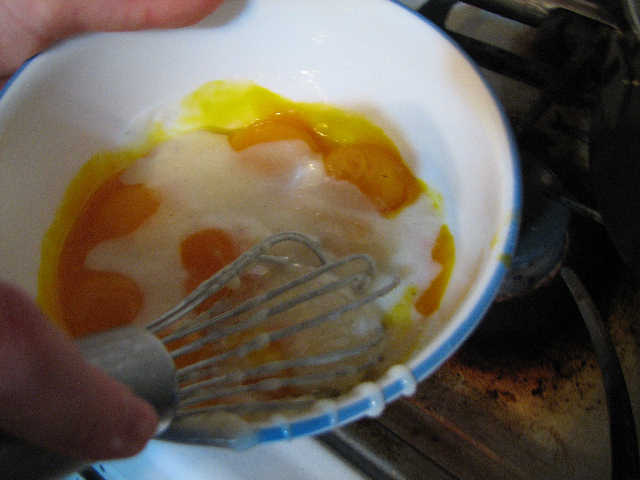
I do that several times, until the bowl begins to feel warm in my hands. Then rapidly whisk the yolk mixture into the milk mixture.
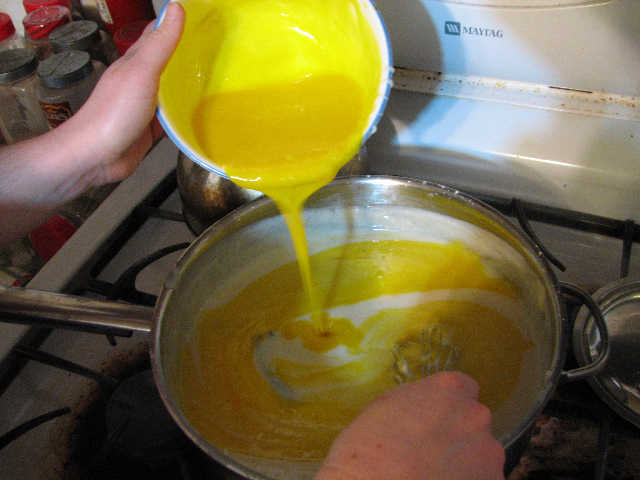
Add the butter in, too, and keep stirring till it’s melted in.

The finished custard:
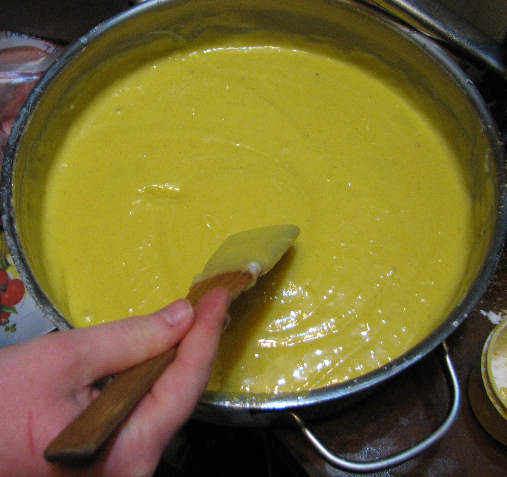
Glaze:
I set up pan with water in the bottom and a glass bowl on top to make my own double boiler. The water underneath the pan should be simmering.

Then I just melt chocolate as needed, in a ratio of 1/2 cup chocolate chips to 2 TB butter. I think I used about 2 cups of chocolate chips and a stick of butter, but I can’t remember.

It should melt until totally smooth, with no lumps.
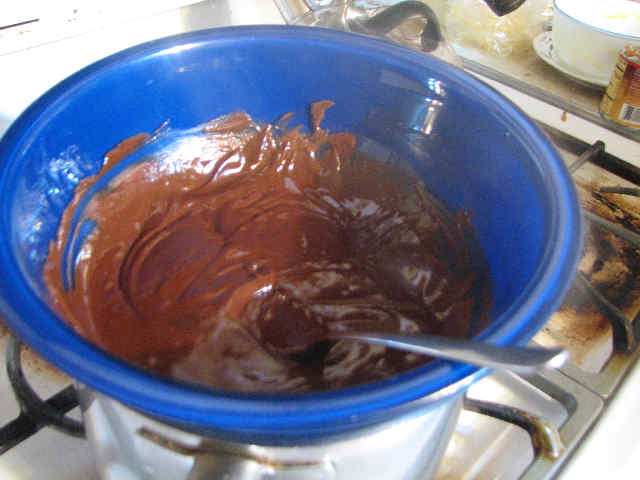
Assembly:
Set-up your pastry bag with a large tip (star or round, it doesn’t matter), and load it with completely chilled filling. Here I’m using a disposable pastry bag.

If it isn’t cold enough, it will slip right through your tip without any pressure, leading to a filling where you want it and where you don’t—in other words, all over the place.
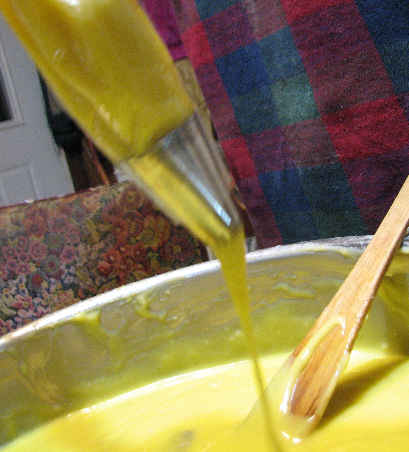
(I left the soupy-filled eclairs on the below-freezing porch while I filled the rest, and also kept my soup custard on the porch between refilling my pastry bag. The colder the custard got, the easier it was to manage, and by the time I finished all filling all the eclairs, the soupy-filled ones had firmed up nicely.)
The steam has made the eclairs mostly hollow (you can break one open to see, or just take my word for it) but they can still have a few walls on the inside. I make two or three holes on the top (just break the holes with your finger), and stick the tip of the pastry bag into the holes. If there is no walls on the inside, you can usually see the filling squirting back up through the other two holes. If you don’t see that happen, you’ll need to fill each hole individually.

These holes get covered with a nice thick layer of glaze.
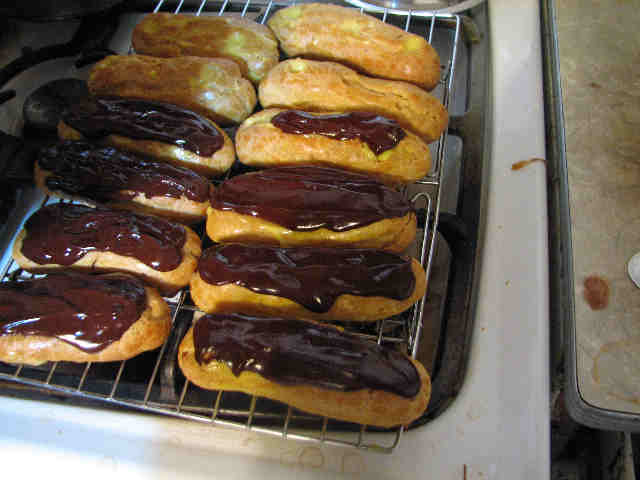
Endless eclairs. Your hours of work will be downed in a few short moments. Yum.
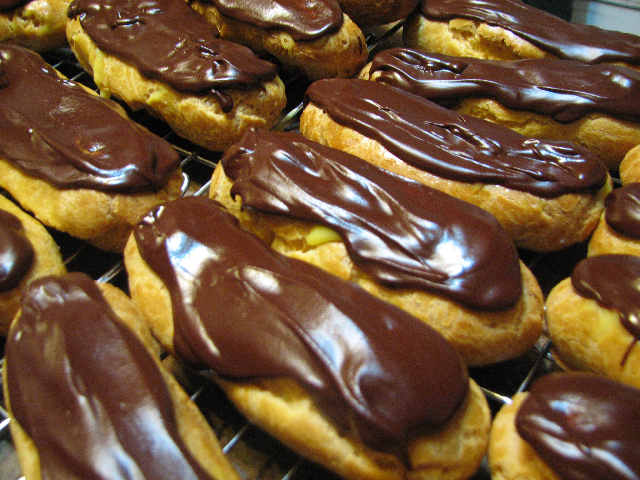
Posted in Uncategorized | 2 Comments »
My biggest and best secret for being a good cook is to only feed hungry people.
I kid you not. I suppose a lot of people think that the saying “Hunger is the best sauce” is a quaint old wives tale, or not really true, like how they used to say “Eat your mashed turnips–children in Africa are starving”. It sounds good and moralizing, but doesn’t really make sense. Well, for your information, it’s not a quaint old wives tale. The only reason why people (or, at the very least, Americans) think so is because they have so very rarely been hungry, if ever. O, they may have thought so. No doubt they even said the were starved, famished, and weak from lack of nourishment. No doubt they even believed it. But I sincerely doubt they had even begun to be hungry. More likely, they were simply no longer full. Which is nearly just as scandalous, I’m sure.
I find this double standard absurd: at wine tastings they will carefully spit out each mouth full of wine, so as not to actually ingest it, and so have their palate dulled by lack of appetite for wine. And yet, at fancy food tastings they don’t have everyone bike for half an hour before hand, or some other sort of mild but true exercise. Don’t they know that being even mildly hungry refines the tastebuds, making every flavor more full and defined? Don’t they know that an unhungry person can detect half as much subtlty as someone prepared to eat? Don’t they realize that all but the bluntest and most powerful flavors are wasted on those who have no need of food?
I’ve often wondered if that’s the reason that in fancy restaurants you can’t tell which things are supposed to be the food and which are supposed to be the decoration. Since people who aren’t really hungry can’t really taste, food of necessity gets judged by other standards. How does it look? Oo, the red looks so pretty next to the green. Look how small it is! Isn’t it just darling? How much does it cost? Ouch! Well, you know you’ve eaten good today.
No, you haven’t. You can’t eat “good” unless you need to eat.
Eating is practically America’s favorite pastime, and yet (or, perhaps, because of it) people have largely forgotten the whole purpose of eating. (Incidentally, they have also forgotten the meaning of the words “hungry” and “starving”. Starving takes a lot longer than you would think.) Eating is about satiating hunger. Eating is about filling what’s empty. Eating is about sustaining and cultivating life. You would never know that by watching their eating habits. There are the conscientious type, who obsess over counting calories. There are the food-y types, who believe in eating expensive food, no matter how gross it is. There are those who eat simply because it’s a thing to do, and not unpleasant. But none of them seem to realize that the best time to eat is when you’re hungry, and the best time to stop is when you’re not.
They cannot even begin to realize what they’re missing out on, because they haven’t been hungry. If they realized how much worse food tastes when you are simply shoveling it in to a mouth that doesn’t care—well, in all honesty, they probably wouldn’t do much different. Let’s face it, you can spit out a mouth full of wine without getting all sweaty–it’s just so much more a reasonable course of action. But not being able to discern tastes, they turn to the basest of instincts: salt, sugar, and fat. Needless to say, the conscientious type people therefore declare war on salt, sugar and fat. A pointless, and terribly faulty, argument. There is nothing wrong with salt, sugar and fat. The problem is that they eat when they are not hungry, and they don’t stop.
I pity the fancy-cook, who must try to find some way to amuse his mindlessly eating audience. He may have awards stacked up to the ceiling, but he has yet to actually cook, or have his work enjoyed. I pity the one who has been deluded into thinking the salt, sugar and fat they ingest by the handful is food, or tastes good. Addicting, yes, as the body reacts under it’s most base instincts, but not food. It cannot sustain or nourish life by itself. And it certainly does not attain to truly tasting good–it does taste, however, and if your senses are so dulled that almost anything that has a taste is said to have a good taste, you might think it meets the requirements.
To feed someone is to provide nourishment. To eat is to be nourished. If those before you are in no need of food, if you have no hunger that needs to be silenced—what is the point of food? It is diminished. It is a play thing. And your tastebuds are diminished. It is all still there, but it’s not being tasted, and it’s not being used.
Only cook for hungry people. Otherwise, it’s a waste of time. And food.
Posted in Uncategorized | 3 Comments »
When it comes to food, barbarians are a lot more picky than you might expect. In fact, food might be the one thing barbarians care the most about.
It has to be hot.
It has to have meat in it.
Fish is not a meat; it’s a vegetable.
When in doubt, add extra virgin olive oil, garlic, onions and tomatoes.
Peanut butter is a poison.
Meat is not to be consumed unless it’s dead.
Meat is not dead unless there is no pink in it.
Only one eating utensil is required: your hand. (Optionally, you can use either a spoon or a fork. A knife is out of the question; that’s what teeth are for.)
The four food groups are: beef, potatoes, gravy, and pie.
Barbarians have more than four food groups. Also included are: pasta, brownies, chicken and garlic.
The more a “food” is processed, the more it becomes like garbage. Fresh ingredients are always superior.
“Chewy” is a complement.
Pasta is always al dente.
Mayonnaise is gross.
Eggs are great. Favorite ways to prepare them include: brownies, chocolate eclairs, chocolate cream pies, pound cake, and other egg-rich pastries.
If that store-bought white bread really were made out of sawdust, it would probably be better. Don’t eat it.
Rice is neither vegetable nor starch; it is a non-food.
Cranberry sauce is a vegetable.
Ketchup is a vegetable.
Balsamic vinegar is good.
Alcoholic drinks are horrible.
You cannot have too much garlic.
Orange juice trumps soda, every time.
After dining, you don’t have to wipe your hands off on your clothing. You can always use someone elses.
Quiche is not even worth addressing. Even you know better than that.
Feta cheese is good.
So is mozzerella, extra-sharp cheddar, sharp cheddar, monterary jack, colby, colby jack, ricotta, and pepper-jack.
Cottage cheese is not good.
American cheese is not a cheese.
Potatoes taste good when cooked in duck fat.
Arugula is a weed.
Fresh spinach is good.
Store bought broccoli has almost no comparison to the vastly superior homegrown broccoli.
Cake mixes are kind of vile, and not really worth making.
Good applesauce is neither watery nor sweet.
If it has tentacles or looks like a bug or grub, it’s not food.
Excessive saltiness is gross.
Beans are a risky business; They can be edible, but they count as neither a starch nor a protein, so they are never anything more than accessories.
A soup is a simply a drink. If you’re trying to make a meal, it must be either a stew or a chowder.
Homemade is better.
They have many other such statutes and proverbs; but this is enough to get you started, should you ever have a horde of barbarians to feed.
Posted in Uncategorized | 4 Comments »